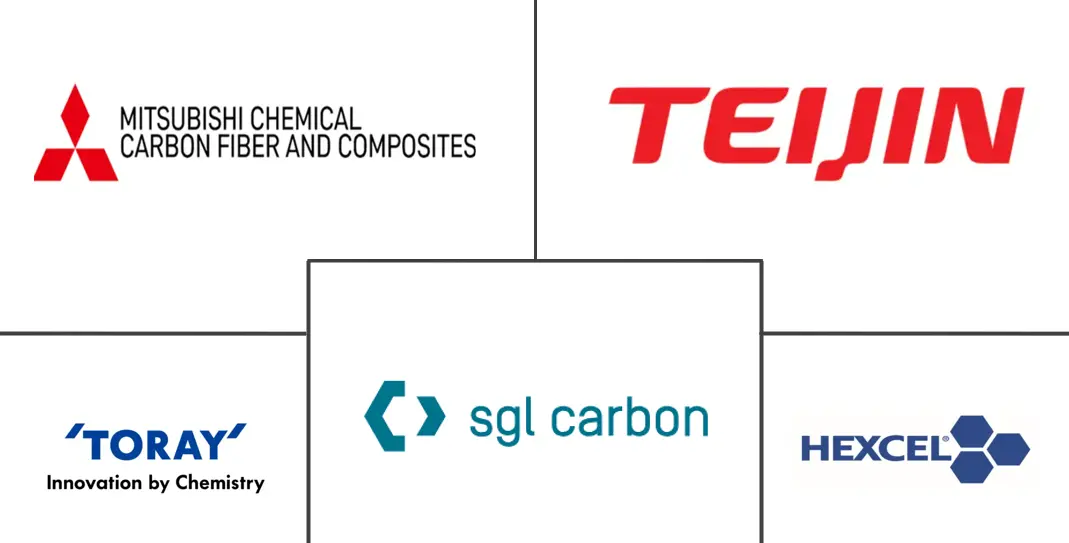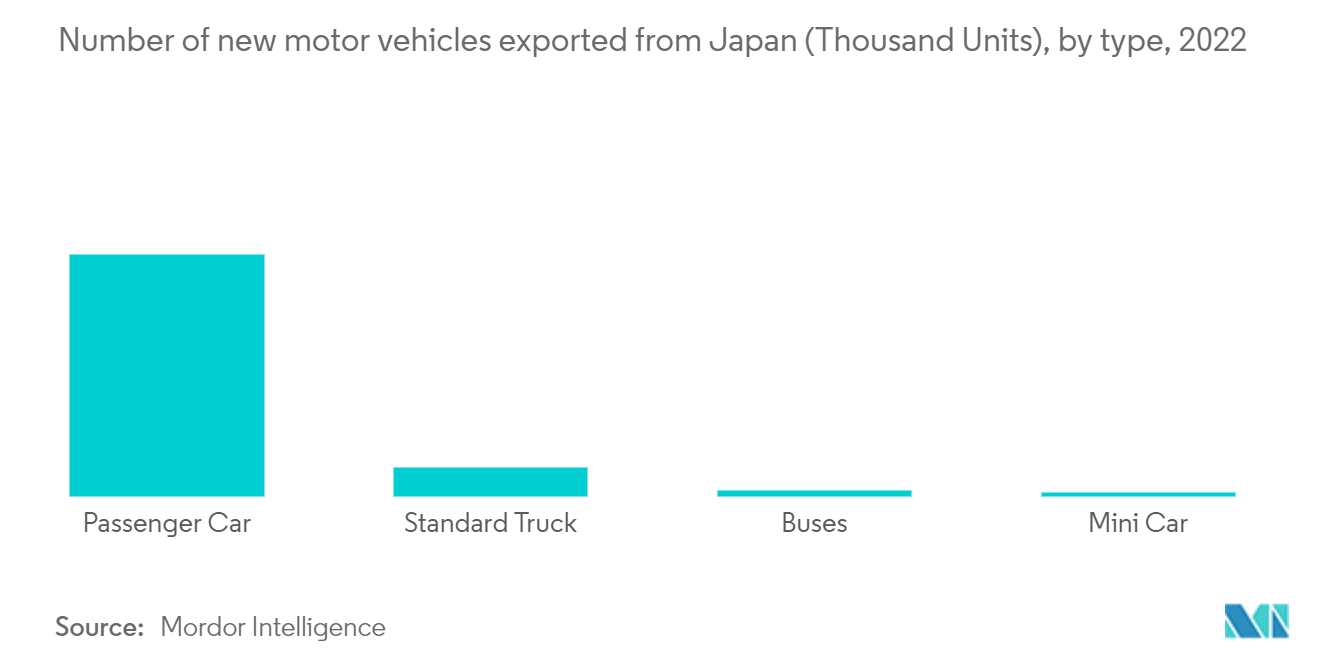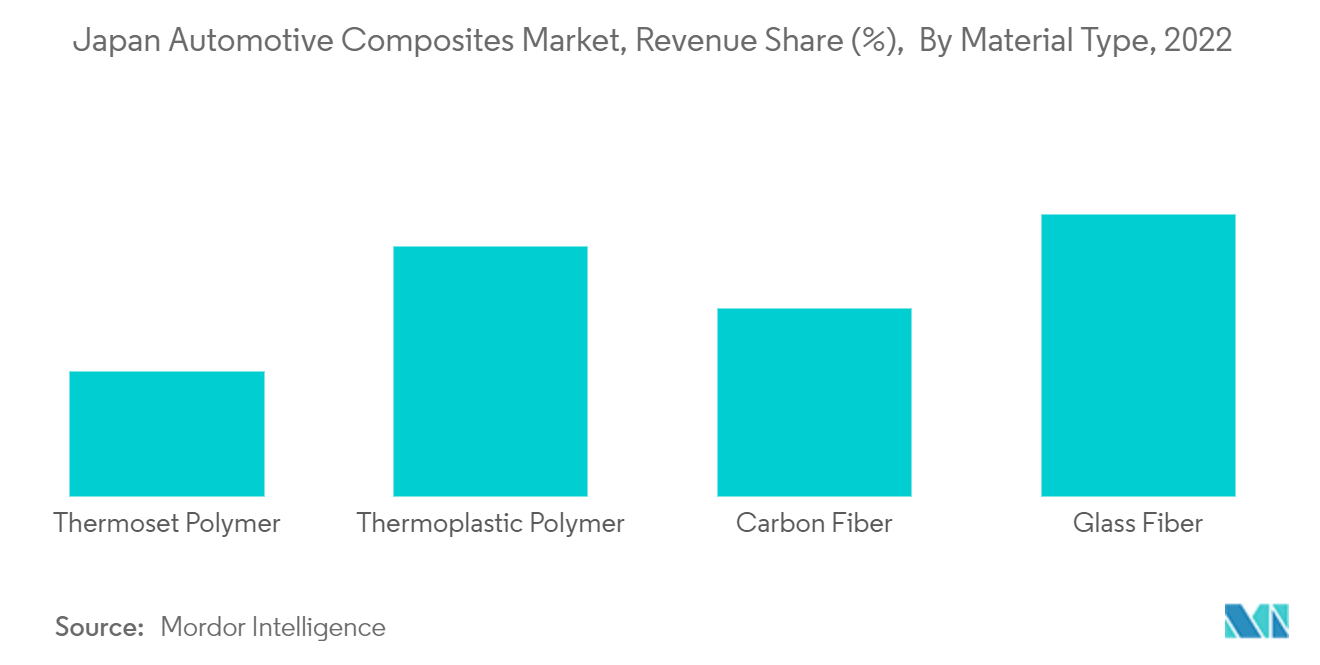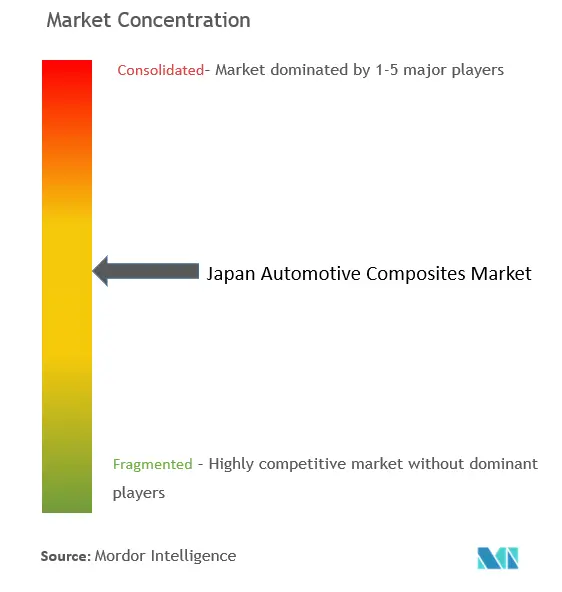Japan Automotive Composites Market Size

| Study Period | 2019 - 2029 |
| Base Year For Estimation | 2023 |
| Forecast Data Period | 2024 - 2029 |
| Historical Data Period | 2019 - 2022 |
| CAGR | 9.00 % |
| Market Concentration | Medium |
Major Players
*Disclaimer: Major Players sorted in no particular order |
Japan Automotive Composites Market Analysis
The Japan automotive composites market was valued at USD 1.77 billion in the current year and is projected to grow to USD 2.97 billion by the next five years, registering a CAGR of 9% in terms of revenue during the forecast period.
Over the medium term, Factors such as increasing demand for lightweight material from the automotive industry and growing focus on fuel economy are expected to be major drivers for the market. However, high costs associated with carbon fiber composites and glass fiber composites are hindering the growth of the market, as their usage in low-cost vehicles could drastically increase the prices of such vehicles.
Presently, composite materials, like thermoplastics and reinforced glass, have drawn the attention of carmakers, making them focus on sourcing better, tensile, and lighter components in the manufacture of automobile units.
The low recyclability of composites is also a restraint for their penetration in entry-level passenger vehicles. However, collaborations of the OEMs with suppliers (due to rising demand for fuel-efficient vehicles, growing lightweight electrical vehicle segment, and major automobile giants, like BMW and Nissan, trying to replace their existing metal parts with composite fibers) imply the scope and booming opportunity that the market is anticipated to offer over the forecast period.
Japan Automotive Composites Market Trends
Growing Demand for Lightweight Materials
The automotive industry has been focusing on vehicle weight for decades, as vehicle weight has a direct impact on driving dynamics and fuel consumption. Due to the high cost of potential lightweight solutions and consumers' limited willingness to pay for weight reduction in automotive, the use of costly lightweight materials has so far been limited.
As governments from around the world are implementing stringent emission regulations and are planning to set even higher emissions standards in the coming years, the importance of lightweight materials will increase. In a typical automobile, the use of fibers is 50% by volume while adding just 10% to the weight.
As per the US Department of Energy (DOE), reducing the weight of vehicles by 10% yields an increase of 6-8% in fuel economy. As a result, companies have started using materials like carbon fiber and glass fiber composites to make vehicles lightweight and fuel-efficient. The usage of glass fiber composites aids in reducing vehicles by 25%.
Apart from carbon fiber, automobile manufacturers have been using glass fiber composites in the manufacturing of numerous automotive components. For instance, Mini Countryman features an interior panel carrier and uses high-flow concentrate long glass fiber-reinforced polypropylene (LGFPP) material (STAMAX resin) from SABIC. The part is 15% lighter in weight than if made from solid plastic. With the demand for lightweight vehicles increasing rapidly in developing economies, the market for carbon fiber composites is projected to grow at a fast pace during the forecast period.
Japan ranks second in the list of car exports. Japan exported more than 3.1 million passenger cars in 2022. Stringent rules and regulations regarding emissions play a huge role in North America and Europe, which has led to an increase in the usage of composites in automobiles to reduce pollution. Passenger cars have the highest share in terms of the usage of composite materials.
The legislative bodies are issuing protocols to include a certain percentage of composite material in automobiles. An increase in fuel efficiency and weight reduction is a major driver that is forcing OEMs to invest in the R&D of composite materials. With corporate average fuel economy requirements increasing and vehicle emission requirements getting stricter in Japan and all over the world, this market is expected to grow during the forecasted period.

Carbon Fiber witnessing major growth
The demand for Carbon fiber is primarily driven by a variety of automotive and truck applications by a long list of advantages, including a high strength-to-weight ratio, excellent corrosion and creep resistance, low maintenance cost, and lightweight.
Manufacturers' increasing use of Carbon fiber composite material to reduce vehicle weight and increase fuel efficiency will boost their sales. All the major premium and electric automakers are increasingly increasing the composite content to address the EU norms regarding carbon emission reduction targets.
Several key players in the market are adopting various growth strategies like partnerships, mergers, and collaborations with major automakers to strengthen their position in the market. For instance,
- In November 2021, SGL Carbon announced that it is involved with the production of state-of-the-art glass fiber fabrics and supply of finished leaf spring components for Ford's F-150 pickup model.
With the abovementioned development across the country, the market is witnessing major growth during the forecast period.

Japan Automotive Composites Industry Overview
The Japanese automotive composite market is dominated by several key players such as Hexcel Corporation, Mitsubishi Chemical Carbon Fiber and Composite Inc, SGL Carbon, Toray Industries Inc., and others. Companies are trying to invent new composites that can reduce the total weight of the vehicle to much lower proportions. For instance,
- In October 2022, Nissan Motors introduced its Frontier pickup truck powered by a 5.6-liter V-8 engine and integrated with a wide-body kit featuring carbon-fiber front fenders and bedsides, along with a carbon hood.
- In July 2022, BASF and TODA KOGYO CORP. expanded the production capacity of BASF TODA Battery Materials LLC (BTBM) at the Onoda site in Japan.
- In September 2021, Mitsubishi Chemical Corporation and Mitsubishi Chemical Advanced Materials Japan Ltd., a subsidiary of MCC, developed a thermoplastic composite material that offers flame retardancy. Both companies have already commenced sample work for some customers and aim to develop new applications such as battery enclosures.
- BMW has adopted carbon fiber-reinforced plastic in a mixed-material approach. Its German competitor, Audi, is also using the material to produce the rear wall of the space frame for its A8 luxury sedan. This part provides around 40% of the vehicle's overall torsional rigidity, making it suitable for manufacture with CFRP. The part is around 50% lighter in weight than its metallic predecessor.
Japan Automotive Composites Market Leaders
-
SGL Carbon
-
Toray Industries, Inc.
-
Teijin Aramid B.V.
-
Mitsubishi Chemical Carbon Fiber and Composites, Inc.
-
Hexcel Corporation
*Disclaimer: Major Players sorted in no particular order

Japan Automotive Composites Market News
- February 2023: Teijin announced to focus on reform in the three fields of composite forming materials, aramids, and health care in Japan.
- May 2022: Hexcel developed a new product range that combines Hexcel resin systems made with bio-derived resin content with natural fiber reinforcements to create material solutions for Automotive, Winter Sports, Marine, and Wind Energy applications.
- February 2022: Teijin Limited expanded its lineup of carbon fiber thermoplastic intermediate materials with three matrix resins: polypropylene/polycarbonate, PC, and polyamide (PA).
Japan Automotive Composites Market Report - Table of Contents
1. INTRODUCTION
1.1 Study Assumptions
1.2 Scope of the Study
2. RESEARCH METHODOLOGY
3. EXECUTIVE SUMMARY
4. MARKET DYNAMICS
4.1 Market Drivers
4.2 Market Restraints
4.3 Porter's Five Forces Analysis
4.3.1 Bargaining Power of Suppliers
4.3.2 Bargaining Power of Buyers/Consumers
4.3.3 Threat of New Entrants
4.3.4 Threat of Substitute Products
4.3.5 Intensity of Competitive Rivalry
5. MARKET SEGMENTATION (Market Size in Value - USD)
5.1 By Material Type
5.1.1 Thermoset Polymer
5.1.2 Thermoplastic Polymer
5.1.3 Carbon Fiber
5.1.4 Glass Fiber
5.1.5 Other Material Types
5.2 By Application Type
5.2.1 Structural Assembly
5.2.2 Power Train Components
5.2.3 Interior
5.2.4 Exterior
5.2.5 Other Application Types
6. COMPETITIVE LANDSCAPE
6.1 Vendor Market Share
6.2 Company Profiles*
6.2.1 3B Fiberglass
6.2.2 Base Materials Ltd
6.2.3 BASF SE
6.2.4 Cytec Industries Inc
6.2.5 Mitsubishi Chemical Carbon Fiber and Composites, Inc.
6.2.6 Nippo Sheet Glass Co Ltd.
6.2.7 SGL Group
6.2.8 Toray Industries Inc
6.2.9 Teijin Limited
6.2.10 Hexcel Corporation
6.2.11 Solvay
7. MARKET OPPORTUNITIES AND FUTURE TRENDS
Japan Automotive Composites Industry Segmentation
Composites are being considered to make lighter, safer, and more fuel-efficient vehicles. A composite is composed of a high-performance fiber (such as carbon or glass) in a matrix material (epoxy polymer) that, when combined, provides enhanced properties compared with the individual materials by themselves. The Japanese automotive composites market is segmented into material type and application. Based on the material type, the market is segmented into thermoset polymer, thermoplastic polymer, carbon fiber, and glass fiber. Based on the application, the market is segmented into structural assemblies, power train components, interiors, exteriors, and other applications. For each segment, the market size and forecast have been done based on the value (USD).
| By Material Type | |
| Thermoset Polymer | |
| Thermoplastic Polymer | |
| Carbon Fiber | |
| Glass Fiber | |
| Other Material Types |
| By Application Type | |
| Structural Assembly | |
| Power Train Components | |
| Interior | |
| Exterior | |
| Other Application Types |
Japan Automotive Composites Market Research FAQs
What is the current Japan Automotive Composites Market size?
The Japan Automotive Composites Market is projected to register a CAGR of 9% during the forecast period (2024-2029)
Who are the key players in Japan Automotive Composites Market?
SGL Carbon, Toray Industries, Inc., Teijin Aramid B.V., Mitsubishi Chemical Carbon Fiber and Composites, Inc. and Hexcel Corporation are the major companies operating in the Japan Automotive Composites Market.
What years does this Japan Automotive Composites Market cover?
The report covers the Japan Automotive Composites Market historical market size for years: 2019, 2020, 2021, 2022 and 2023. The report also forecasts the Japan Automotive Composites Market size for years: 2024, 2025, 2026, 2027, 2028 and 2029.
Japan Automotive Composites Industry Report
Statistics for the 2024 Japan Automotive Composites market share, size and revenue growth rate, created by Mordor Intelligence™ Industry Reports. Japan Automotive Composites analysis includes a market forecast outlook to for 2024 to 2029 and historical overview. Get a sample of this industry analysis as a free report PDF download.



